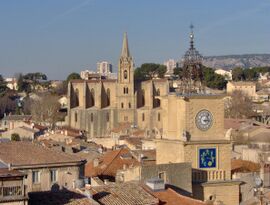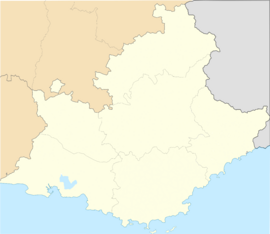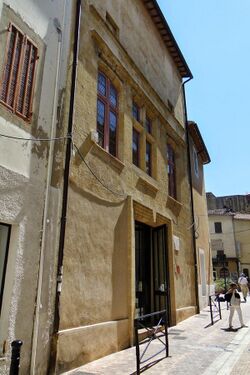Salon-de-Provence
Topic: Unsolved
 From HandWiki - Reading time: 5 min
From HandWiki - Reading time: 5 min
Salon-de-Provence Selon de Provença (Occitan) | |
|---|---|
Commune | |
 A view of Salon-de-Provence, with the church and clock tower | |
| Coordinates: [ ⚑ ] 43°38′26″N 5°05′50″E / 43.6406°N 5.0972°E | |
| Country | France |
| Region | Provence-Alpes-Côte d'Azur |
| Department | Bouches-du-Rhône |
| Arrondissement | Aix-en-Provence |
| Canton | Salon-de-Provence-1 and 2 |
| Intercommunality | Aix-Marseille-Provence Metropolis |
| Government | |
| • Mayor (2020–2026) | Nicolas Isnard[1] (LR) |
| Area 1 | 70.3 km2 (27.1 sq mi) |
| Demonym(s) | Salonais, salonaise (French) Selonenc, selonenca (Occitan) |
| Time zone | UTC+01:00 (CET) |
| • Summer (DST) | UTC+02:00 (CEST) |
| INSEE/Postal code | 13103 /13300 |
| Elevation | 53–325 m (174–1,066 ft) |
| 1 French Land Register data, which excludes lakes, ponds, glaciers > 1 km2 (0.386 sq mi or 247 acres) and river estuaries. | |
Salon-de-Provence (French pronunciation: [salɔ̃ d(ə) pʁɔvɑ̃s], Template:IPA-frdia; Provençal Occitan: Selon de Provença/Seloun de Provènço, [seˈlu de pʀuˈvɛnsɔ]), commonly known as Salon, is a commune located about 52 km (32 mi) northwest of Marseille in the Bouches-du-Rhône department (Metropolis of Aix-Marseille Provence), region of Provence-Alpes-Côte d'Azur, Southern France. It is the home of an important French Air and Space Force (Armée de l'Air et de l'Espace) air base.
History
Salon was a Gallo-Roman oppidum well positioned on the salt trade routes between Adriatic, Atlantic and Mediterranean seas, hence its name. This region was under the Phocaean influence since the sixth century BC, and stretches of the Via Aurelia can still be recognized just outside the town, but the earliest mention of the place under its familiar name is of the ninth century, as Villa Salone. The archbishops of Arles controlled the site.
Its principal claim to fame today is as the place where Nostradamus spent his last years and is buried. His dwelling is maintained as a museum, and for four days every June or July, the city celebrates its history during the time of Nostradamus, attracting tourists.
The historic center still lies within its circuit of walls, entered through two seventeenth-century gateways, the Porte de l'Horloge and the Port Bourg Neuf.
In 1559 the engineer Adam de Craponne opened the Canal de Craponne to bring fresh water from the river Durance to the town and the surrounding plain of Crau. Inexpensive freight brought commerce to Salon, and the town prospered.
Sights
Château de l'Emperi
The castle, which was the biggest in Provence during the 12th and 13th centuries and was mentioned as early as the tenth, still dominates the old town. It was the preferred residence of the bishops of Arles, when Provence was part of the Holy Roman Empire, hence its name. It became the property of the city after the French Revolution . After damage caused by the 1909 earthquake, it has been restored and now hosts a museum of military history. Every summer, it hosts an international classical music festival.
Fontaine Moussue
The fountain in Place Crousillat has existed since the 16th century. During the 20th century, limestone concretions and vegetation developed, giving the familiar mushroom aspect.
St Michel Chapel
Built during the 13th century, this chapel boasts a remarkable Romanesque tympanum featuring the paschal lamb.
Collégiale Saint Laurent
The current edifice was erected during 15th century by Cardinal Louis Aleman, who was then bishop of Arles.
Salon-de-Provence Air Base
Salon-de-Provence Air Base is the site of the French Air Force Academy, as well as the home of the French Aerial Demonstration team, the Patrouille de France.
Market
Every Wednesday the Place Morgan is host to a Provençal market.
Culture
Each summer, the Château de l'Empéri hosts a festival of chamber music.
Some years the Château is the venue for Nostradamiques – an historical re-enactment of the time of Nostradamus which includes processions and a transformation of the old medieval downtown. One such re-enactment was performed by the television presenter Jean-Pierre Foucault. In 2006 Robert Hossein compered the closing ceremony of the re-enactment.
Personalities
- Abba Mari ben Eligdor (fl.1335), distinguished Talmudist, philosopher, resident 14th Century
- Nostradamus (1503–1566), resident 1547–66, place of death
- Adam de Craponne (1526–1576), engineer, born in Salon
- Miquèu Tronc (16th century), Occitan language writer
- Jean Baptiste Christophore Fusée Aublet (1720–1778), French botanist and explorer, birthplace
- Joan Montseny (1864-1942), Catalan anarchist, place of death
- Charles Trenet (1913-2001), French singer, resident for military reasons, 1939–1940
- Romain Gary (1914–1980), French novelist and pilot, learnt to fly with military in Salon-de-Provence before Nazi occupation of France
- Patrick Baudry (1946-), and Léopold Eyharts (1957-), French astronauts, military training
- Daniel Goossens (1954-), Cartoonist, birthplace
- Christine Boisson (1956-), French actor, birthplace
- Franck Esposito (1971-), French swimmer, birthplace
- Michaël N'dri (1984-), footballer, birthplace and early Football career
- Mathieu Arzeno (1987-), racing driver, birthplace
- Simon Porte Jacquemus (1990-), Fashion Designer[2]
- Nassourdine Imavov (1995-), MMA fighter, former resident
- Sakina Karchaoui (1996-), footballer for Paris Saint-Germain and the France national team
Twin towns – sister cities
Salon-de-Provence is twinned with:[3]
 Blanzy-la-Salonnaise, France
Blanzy-la-Salonnaise, France Aranda de Duero, Spain
Aranda de Duero, Spain Gubbio, Italy
Gubbio, Italy Huntingdon, England, United Kingdom
Huntingdon, England, United Kingdom Godmanchester, England, United Kingdom
Godmanchester, England, United Kingdom Szentendre, Hungary
Szentendre, Hungary Wertheim am Main, Germany
Wertheim am Main, Germany
Gallery
Tympanum, Eglise St-Michel
Population
| Historical population | |||||||||||||||||||||||||||||||||||||||||||||||||||||||||||||||||||||||||||||||||||||||||||||||||||||||||||||||||||
|---|---|---|---|---|---|---|---|---|---|---|---|---|---|---|---|---|---|---|---|---|---|---|---|---|---|---|---|---|---|---|---|---|---|---|---|---|---|---|---|---|---|---|---|---|---|---|---|---|---|---|---|---|---|---|---|---|---|---|---|---|---|---|---|---|---|---|---|---|---|---|---|---|---|---|---|---|---|---|---|---|---|---|---|---|---|---|---|---|---|---|---|---|---|---|---|---|---|---|---|---|---|---|---|---|---|---|---|---|---|---|---|---|---|---|---|
|
| ||||||||||||||||||||||||||||||||||||||||||||||||||||||||||||||||||||||||||||||||||||||||||||||||||||||||||||||||||
| Source: EHESS[4] and INSEE (1968-2017)[5] | |||||||||||||||||||||||||||||||||||||||||||||||||||||||||||||||||||||||||||||||||||||||||||||||||||||||||||||||||||
Climate
Script error: No such module "weather box".
See also
- Communes of the Bouches-du-Rhône department
References
- ↑ "Répertoire national des élus: les maires" (in fr). data.gouv.fr, Plateforme ouverte des données publiques françaises. 6 June 2023. https://www.data.gouv.fr/fr/datasets/r/2876a346-d50c-4911-934e-19ee07b0e503.
- ↑ "Simon - JACQUEMUS | Official website" (in en-US). JACQUEMUS | Official website. https://www.jacquemus.com/simon/.
- ↑ "Villes jumelles" (in fr). Salon-de-Provence. http://www.visitsalondeprovence.com/salon-de-provence/villes-jumelles.
- ↑ Template:Cassini-Ehess
- ↑ Population en historique depuis 1968, INSEE
- ↑ "Données climatiques de la station de Salon-de-Provence" (in fr). Meteo France. http://www.meteofrance.com/climat/france/salon-de-provence/13103001/normales.
- ↑ "Climat Provence-Alpes-Côte d'Azur" (in fr). Meteo France. http://www.meteofrance.com/climat/france/provence-alpes-cote-dazur/regi93/normales.
- ↑ "Salon de Provence (13)" (in fr). Fiche Climatologique: Statistiques 1981–2010 et records. Meteo France. https://donneespubliques.meteofrance.fr/FichesClim/FICHECLIM_13103001.pdf.
- ↑ "Normes et records 1961-1990: Salon de Provence (13) - altitude 59m" (in fr). Infoclimat. http://www.infoclimat.fr/climatologie-07648-salon-de-provence.html.
External links
| Wikisource has the text of the 1911 Encyclopædia Britannica article Salon. |
 |
 KSF
KSF












